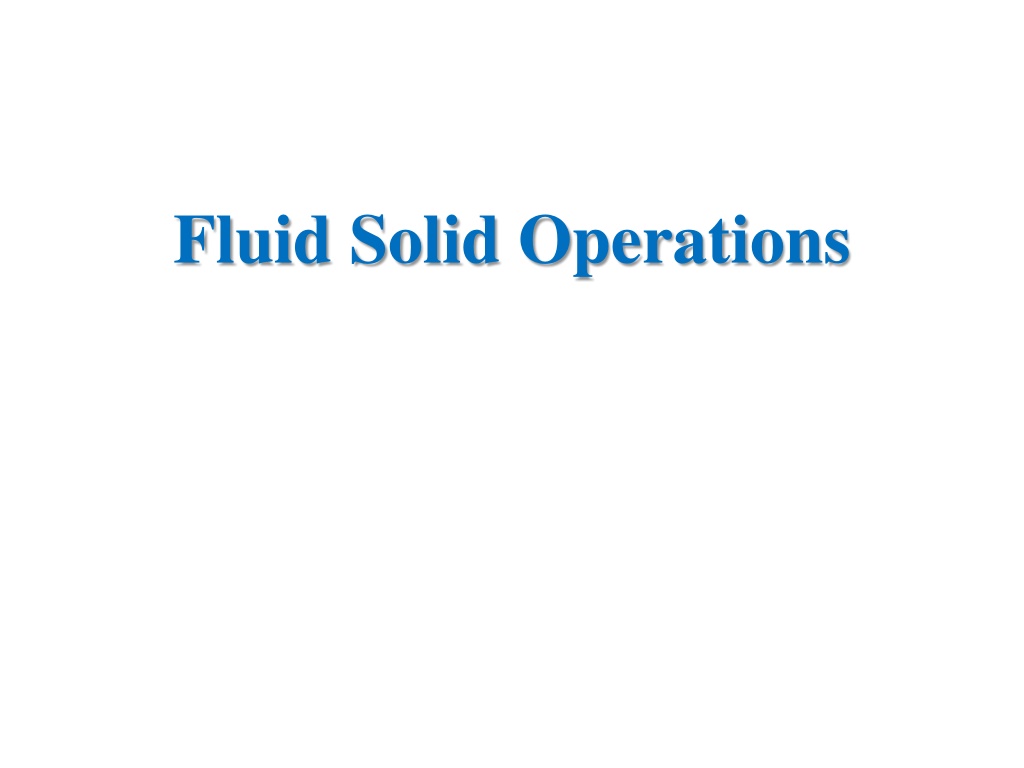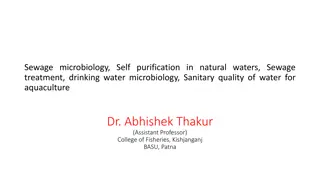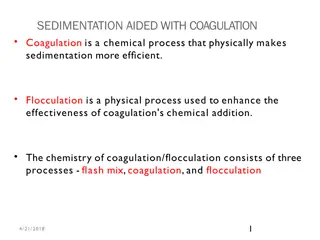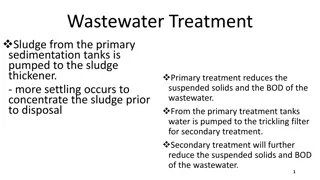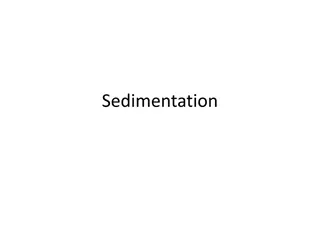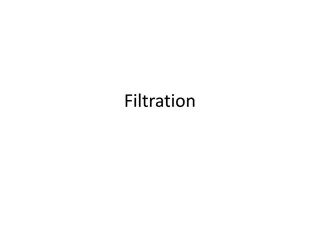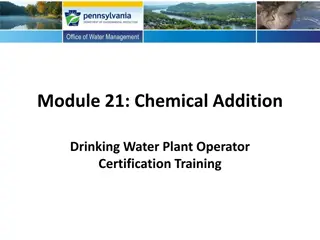Understanding Sedimentation in Water Treatment Processes
Sedimentation is a crucial unit operation in water treatment involving the settling of solids in liquids to form sediments. Gravity plays a key role in this process, drawing particles towards the bottom of the vessel. Differentiating between settling and sedimentation is important, with settling being the initial phase where particles move downward due to gravity. Various removal mechanisms such as gravity separation, filtration, and flotation are employed in sedimentation tanks to achieve effective solids separation. Considerations like particle specific gravity, size distribution, and removal mechanisms are vital in optimizing sedimentation processes.
Download Presentation

Please find below an Image/Link to download the presentation.
The content on the website is provided AS IS for your information and personal use only. It may not be sold, licensed, or shared on other websites without obtaining consent from the author. Download presentation by click this link. If you encounter any issues during the download, it is possible that the publisher has removed the file from their server.
E N D
Presentation Transcript
THEORY OPERATION DESIGN
THEORY Also referred as SEDIMENTATION TANKS . Settling- process by which particulates settle to the bottom of a liquid and form a sediment. Particles experience a force, either due to gravity or due to centrifugal motion; tend to move in a uniform manner in the direction exerted by that force. Gravity settling- the particles will tend to fall to the bottom of the vessel, forming a slurry at the vessel base. For dilute particle solutions, two main forces enacting upon particle. Primary force is an applied force, such as gravity, and a drag force that is due to the motion of the particle through the fluid. The applied force is not affected by the particle's velocity; the drag force is a function of the particle velocity.
Settling or Sedimentation Settling- a unit operation in which solids are drawn toward a source of attraction. The particular type of settling that will be discussed in this section is gravitational settling. It should be noted that settling is different from sedimentation. Sedimentation- The condition whereby the solids are already at the bottom and in the process of sedimenting. Settling is not yet sedimenting, but the particles are falling down the water column in response to gravity. Of course, as soon as the solids reach the bottom, they begin sedimenting. In the physical treatment of water and wastewater, settling is normally carried out in settling or sedimentation basins.
Removal Mechanisms Gravity separation Settling tanks, tube settlers and hydro cyclones Filtration Screen, Granular media, or porous media filter Flotation Foam Fractionation Recirculating Aquaculture Systems Short Course
2 p ( g ) D p = V s 18 Settling Basins Advantages Simplest technologies Little energy input Relatively inexpensive to install and operate No specialized operational skills Easily incorporated into new or existing facilities Disadvantages Low hydraulic loading rates Poor removal of small suspended solids Large floor space requirements Re-suspension of solids and leeching Recirculating Aquaculture Systems Short Course
Solids Physical Characteristics particle specific gravity particle size distribution Two most important physical characteristics of suspended solids: Recirculating Aquaculture Systems Short Course
DESIGN In specifying a water and wastewater sedimentation tank size, the major features to be considered are: - tank cross sectional area, - tank depth, and type of cleaning mechanism used. In specifying a design basis for water and wastewater sedimentation tanks; three conditions are commonly considered: - solid handling capacity (kg/day), - overflow rate (lpm/m2), - detention time. Additional design data required to ascertain mechanical construction, specific gravity of solids, size distribution of solids, underflow construction, operating temperature, and geographical location. Typical dimensions of sedimentation tanks are given in Table 1.
2 p ( g ) D p = V s 18 Sedimentation ( 2 p ) g D p = V s 18 Stokes Law Denser and large particles have a higher settling velocity Recirculating Aquaculture Systems Short Course
Settling Basins Design to minimize turbulence: length:width = 4:1 to 8:1 inlet outlet effective settling zone 1 2 m sludge zone full-width weir chamfered weir to enhance laminar flow (85% of water depth) Recirculating Aquaculture Systems Short Course
Settling Basins Overflow rates are used for design: Vo 3 ( / ) Flow Rate m s = Overflow Rate 2 ( ) settling surface area m length width settling surface area = length x width flow flow Recirculating Aquaculture Systems Short Course
Settling Basin Design "Rule of Thumb" Settling Basin Design basin floor area of 41 Lpm per m2 of flow. 250 to 410 Lpm per m width of weir for outflow. submerge inlet weir 15% of basin water depth. use 25 cm wide weirs and use rounded edges . maximize length of settling chamber as much as possible. Recirculating Aquaculture Systems Short Course
Settling Tanks, Basins, or Clarifiers Generally, two types of sedimentation basins (also called tanks, or clarifiers) are used: Rectangular and Circular. Rectangular settling, basins or clarifiers, are basins that are rectangular in plans and cross sections. In plan, the length may vary from two to four times the width. The length may also vary from ten to 20 times the depth. The depth of the basin may vary from 2 to 6 m. The influent is introduced at one end and allowed to flow through the length of the clarifier toward the other end.
